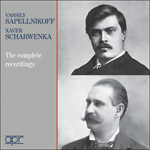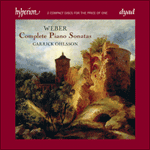
Welcome to Hyperion Records, a British classical label devoted to presenting high-quality recordings of music of all styles and from all periods from the twelfth century to the twenty-first.
Hyperion offers both CDs, and downloads in a number of formats. The site is also available in several languages.
Please use the dropdown buttons to set your preferred options, or use the checkbox to accept the defaults.

| Garrick Ohlsson (piano)» More |
If the Moderato introduction is more effective in the Berlioz version—where the solo cello and the answering woodwind might seem to offer a more eloquent interpretation of the gentleman’s increasingly pressing invitation and the lady’s correspondingly warmer replies—the dance itself is highly idiomatic piano music. Usually described as a rondo, the Allegro vivace is actually a complex construction including three waltzes, each with its main and subsidiary themes. The main theme is the vigorous upward arpeggio that plunges the dancers into the first waltz, which also includes a more gentle idea with mazurka-like displaced rhythmic accents and, before the return of the main theme, an episode of keyboard bravura. Both the second waltz, beginning with a delightful rocking melody picked out on the first beat of each bar, and the third waltz, based on a minor-key variant of the main theme, are shorter than the first but no less tuneful. Surprisingly, the one passage of development is devoted to the second theme of the opening waltz (now without its mazurka accents) rather than the main theme—which is being held in reserve for an exhilarating recapitulation and a brilliant coda. The end of the waltz is not quite the end of the piece: in the Moderato closing bars the dancers exchange parting compliments with a nice appreciation of musical as well as social form.
from notes by Gerald Larner © 2009
Si l’introduction Moderato est plus impressionnante chez Berlioz—où le violoncelle solo et les bois qui lui répondent paraissent offrir une interprétation plus éloquente de l’invitation de plus en plus pressante du monsieur et des réponses toujours plus chaleureuses de la dame—, la danse elle-même est une musique pianistique des plus idiomatiques. Généralement décrit comme un rondo, l’Allegro vivace est un amalgame complexe faisant intervenir trois valses, chacune bithématique (thèmes principal et secondaire). Le thème principal est le vigoureux arpège ascendant qui plonge les danseurs dans la première valse, où apparaissent aussi une idée plus douce avec des accents rythmiques déplacés à la mazurka et, avant le retour du thème principal, un épisode de bravoure au clavier. La deuxième valse, s’ouvrant sur une savoureuse mélodie berçante accentuée sur le premier temps de chaque mesure, et la troisième, fondée sur une variante en mineur du thème principal, sont plus courtes que la première mais non moins mélodieuses. Étonnamment, le seul passage de développement est consacré au second thème de la valse inaugurale plutôt qu’au thème principal (désormais veuf de ses accents de mazurka), lequel est gardé en réserve pour une exaltante réexposition et une brillante coda. La fin de la valse ne marque pas tout à fait la fin de la pièce: dans les mesures conclusives Moderato, les danseurs s’échangent des compliments d’adieu avec une belle intelligence de la forme musicalo-sociale.
extrait des notes rédigées par Gerald Larner © 2009
Français: Hypérion
Wenn die Moderato-Einleitung in dem Arrangement von Berlioz wirkungsvoller ist—hier scheinen das Solocello und die darauf antwortenden Holzbläser eine effektivere Interpretation der immer eindringlicher werdenden Aufforderung des Herrn und der zusehends entgegenkommenderen Antworten der Dame darzustellen—so ist doch der Tanz selbst in der Klavierfassung besonders ausdrucksvoll. Das Allegro vivace, das sonst oft als Rondo beschrieben wird, ist in Wirklichkeit eine komplexe Konstruktion mit drei Walzern, die jeweils Haupt- und Nebenthemen haben. Das Hauptthema ist das energische, nach oben gerichtete Arpeggio, das die Tänzer in den ersten Walzer befördert, in dem ebenfalls ein sanfteres Motiv mit versetzten rhythmischen Akzenten, ähnlich einer Mazurka, erklingt, bevor das Hauptthema mit einer Bravurpassage zurückkehrt. Sowohl der zweite Walzer mit einer anmutig wiegenden Melodie aus den jeweils ersten Taktschlägen als auch der dritte Walzer, der auf einer Mollvariante des Hauptthemas basiert, sind kürzer als der erste, aber darum nicht weniger melodiös. Überraschenderweise ist die Durchführung dem zweiten Thema des ersten Walzers gewidmet, und nicht dem ersten (was nun ohne die Mazurka-Akzente erklingt): dieses wird für eine belebende Reprise und brillante Coda in Reserve gehalten. Der Schluss des Walzers ist noch nicht das Ende des Stückes: in den Moderato-Schlusstakten beglückwünschen sich die Tänzer gegenseitig mit einer erfreulichen Würdigung musikalischer und sozialer Form, bevor sie sich voneinander verabschieden.
aus dem Begleittext von Gerald Larner © 2009
Deutsch: Viola Scheffel
 Vassily Sapellnikoff & Xaver Scharwenka - The complete recordings Vassily Sapellnikoff & Xaver Scharwenka - The complete recordingsVassily Sapellnikoff (1868–1941) and Xaver Scharwenka (1850–1924) were among the earliest generation of pianists to record, and on this ground alone it is surprising that their complete recordings have never before been transferred for modern list ...» More |
 Weber: Complete Piano Sonatas Weber: Complete Piano SonatasGarrick Ohlsson is acclaimed for his performances of Brahms and Chopin on Hyperion. These delightful recordings were originally released on Arabesque.» More |

